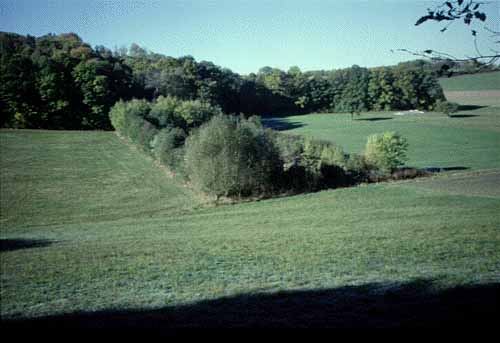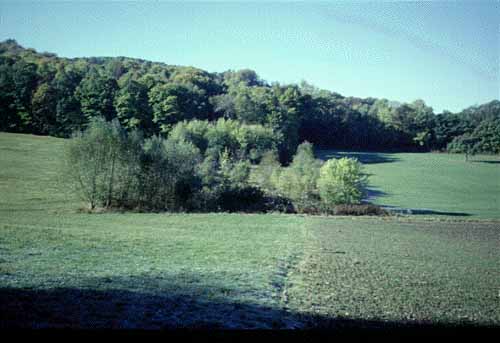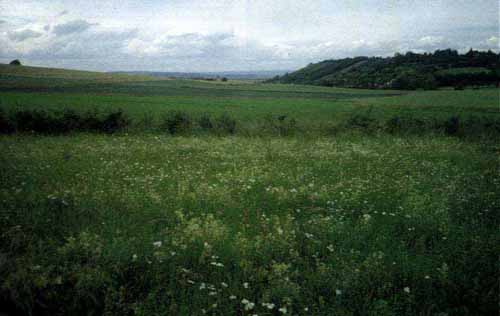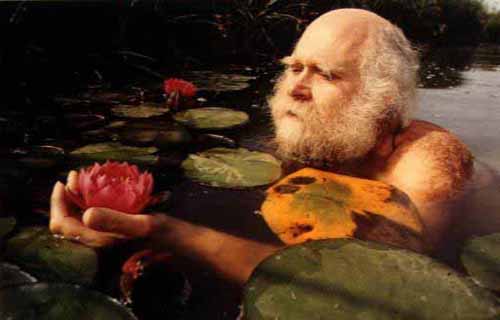|
herman's meadow lies at a strategically important place: slightly sloping, a forest at its back bordered by a small stream at its foot, at the beginning of a valley which opens up widely onto a rolling plateau, yet which before dissolving into the landscape, is accentuated by the ancient church - built on a tumulus - of Eschenau, an inconspicuous village crouched in the landscape at the edge of Steiger Forest. herman's meadow is discernible even from a distance - not as a meadow, but as a peculiar, different moment, as a wild, unrestrained piece of land in the midst of a cleared landscape accessible to machines - by the hedges surrounding it. It drives like a wedge out of the forest into the open field of industrialised agriculture, radiating more than formal unrest. For it is bursting with life.
herman de vries began his project `wiese' (meadow) together with his wife Susanne as a consequence of his work as an artist. They bought a piece of land, approximately 400 square meters, more than six years ago. As a border, thcy planted a hedge composed of a variety of shrubs: hazel, hawthorn, blackthorn, dogrose, euonymus, viburnum, rowanberry and privet; as well as a row of cultivated and semi-cultivated trees: hazelnut, rowan, cornelian cherry, medlar, older varieties of apple, pear and plum - and let it take its natural course. Late in the year, after seeding, half of the area was cut and thc cuttings removed, so that the fodder meadow - overfertilised up till then with artificial fertilisers and liquid manure three times yearly - would lose some of its richness. In the following year, herman and Susanne collected seeds along emhankments, paths along the edge of the forest from plants that had been resistant to thc farmers' machines and liquid manure sprays and planted them in their meadow: in molehills and earth which had bcen dug up by wild boars. Consequently, columbine, naked lady, alchemilla, scabious, pincushion flower, agrimony, angelica, avens, meadow salvia, primrose, valerian, mugwort, leonorus, yellow iris, comfrey, carnations, hops, byrony, rhinanthus and belladonna had a chance to spread. These were joined spontaneously by spiraea, saxifrage, red clover, wood anemone and blue cranesbill; and runners from thc aspen at the end of the forest developed shoots in the upper part of the meadow.
After only two years the meadow had clearly altered its appearance: because the grass was not fertilised, it remained shorter and grew in bushy tufts; instead, herbs and clover shot up high. A large number of moles burrowed in the earth and there were more and more insects: beetles, butterflies, grasshoppers and different kinds of arachnids made the meadow their habitat. They were followed by birds and small animals for which herman and Susanne had created the ideal living conditions in the hedges. Then, after fixing up a watering place which was dry in summer, dragonflies, salamanders and frogs, and ultimately, last year, large numbers of wild boar, which had discovered the abundant supply of larvae in the earth, moved in. Now, after six years of intensive work, the meadow differs quite visibly from the agricultural acreage around it: a wood of small aspens creates a natural barrier to the forest road, and the hedges, now man-high, shield the meadow from the surrounding manure and pesticide culture. One enters the meadow through an opening in the hedge at one of the upper corners and finds oneself in an almost paradisiacal field in which it hums and buzzes, in which birds twitter, grasshoppers chirp and countless other animals creep through the vegetation. Guided by herman who strictly watching that only certain paths are taken, explaining the grounds, sharpening the visitors attention by making reference to certain plants and animals, a smell here, a taste there, recommending a view or that one stay a while in one place - hands over the book of Nature in a very gentle, but resolute manner to an ignorant, naive city person like me, who can hardly recognise in this wilderrness thc caring hand that has given it order. It is a confusing experiencc trying to see this Central European and highly varied biotope of not even half a hectare as a landscape which has been cultivated by man. Neatly weeded beds, regulated streams and tracts of land that have been freed from trees and shrubs have influenced our notion of Nature to such a degree that here, in this meadow, the more obvious arrangements become the mainstay of perception. The circle of roses which herman and Susanne planted with different Central European varietics at one edge of the meadow constitutes a biotope which may not bc entered, and the small ring of hornbeams which was laid out three years ago on another site, is designed to protect thc couple and their guests from unexpected changes in weather.
A meadow, one relearns on being faced with this piece of land in Upper Franconia, is a particular form of landscape, Nature made arable, which - depending on the conditions of the soil and land - can develop specific vegetations and possible uses. A lexicon lists fourteen different types of meadows, from forest and moor to valley and mountain, not counting acid and akaline, wet, moist and dry meadows. Furthermore, a meadow differs from a pasture in that it is land with a layer of grass, varieties of clover and herbs, the yield of which is meant to bc harvested and fed fresh or as hay to animals. As a significant basis for animal and dairy farming, the meadows - artificially fertilised and cut as many as four times a year - became central to an extremely shortened natural cycle, although at a heavy price. The intensive cultivation has led to an impoverishment of varieties, especially of herb varieties, with the result that the animals nourished by these meadows, no longer stabilised by the manifold effects of such herbs, have for the most part lost their relationship to Nature. herman de vries' meadow is, as the farmers of the area know quite well, the alternative to the rigid Nature cultivation program, the present extreme form of which began with the consolidation of arable land in the sixties. Hedges and scattered fruit trees were its primary victims. And it is also due to this program that the countryside - cut in sizeable strips like a highway - largely presents itself as barren land. Hence, the farmers watch the meadow project suspiciously, but without aggression. For they know, whether they want to admit it or not, that herman and Susanne are working on their history, developing a museum of their culture and countryside. herman's meadow is a museum in the best sense of the word, a
place which, due to intensive and competent collecting, is the actual reconstruction, thc
living image of a former, generally prevailing manner of treating Nature, a striking,
not-to-be-overlooked place of reflection wherethe history and future of the region,
culture and Nature merge. And it is here, in the particular, in this small piece of land,
that a general basic problem can be recognised. `Decultivation for renaturalization' is the concept by which herman de vries treats his meadow as an artist, that is, as a thinking ‘maker of culture'. The maxim by which de vries works is not the encroachment on Nature, but the encroachment on the countryside, on a Nature which has been badly treated by humans. Yet this project, which deals with a specific landscape and aims at the reconstruction of it as cultivated land prior to its industrialization, is - compared to what herman usually creates - a kind of applied art. The artist, now sixty years old earned his reputation not only as a great authority on, medicinal herbs and natural drugs, but also as one of the few to understand how to deal with Nature, in particular with plants, concretely: proceeding from the zero-idea of the early sixties, de vries, unlike many of his fellow artists, took ‘zero’ seriously as an epistomelogical position and made it the basis for a fantastic sounding, but very well-considered leap out of our culture. Since this period, de vries no longer functionalises reality for the production of art or science, but subordinates artistic as well as scientific work (`to form') to the task - Nature: to bring reality as itself into the foreground, to make it vivid. With this approach, herman de vries has left thc realm of the artistic avantgarde, and instead questions it from his `200 square kilometer atelier'. In his attitude, de vries is only comparable to John Cage or Marcel Duchamp. Yet unlike them, he does not deal with conventions within our culture, but with culture as convention, with culture as a concrete form of dealing with natural reality. Hence, de vries' work does not aim at the salvation of the function of art and the artist under the circumstances of industrialised society; on the contrary, his efforts are for a salvation of the consciousness that there is a reality which - independently of whether it is understood or can be dealt with by us - exists and is valid for us, and is,indeed, even more: it is binding. As a consequence, de vries has not developed his own style to resolve this problem, but adopted several simple work methods which have been tried and tested in both the artistic and scientific context: for example, the collecting, drying, pressing, grinding and classifying of the materials found. In this way, de vries has been able to open up the border between art and science, as well as arrive at their common basis through the unconventional, direct application of these techniques. For instance, de vries works as a scientist when he plucks sixteen leaves from a small maple tree, spreads them out next to each other and examines them morphologically; yet, being a true artist, he reveals the diversity and variability of his research objects - making `normal' science, which aims at finding common features, impossible. As a result of his activities, which he presents as work of art, small maple leaves can no longer be perceived as meaningless bits of Nature or mere proof of the Linnaean system of classification. One is forced to recognise that leaves exist which all come from the maple, yet no two are exactly identical. Thus the maple leaves which have been `worked on` by de vries begin to counteract our habitual style of perception and open our eyes: by the actual examination of the leaves occasioned by the artist, a principle is revealed in them, the plan which they share; yet this examination inevitably includes the experience that - as no two leaves are identical - this plan is merely an ideal: an image which we make for our orientation and call maple. herman de vries has tested this approach in a variety of aspects, to return again and again to the meadow as theme. His first and perhaps most important work in this context was the installation `16 dm2 wiese' (16 dm2 meadow) dating from 1974, exhibited in the Vleeshal in Middelburg in 1979. For this work, he dug up a square with a side length of 40 cm out of a meadow, took it apart and completely filled the walls of a relatively large room with the individual, pressed plants, each glued on to a piece of paper. Not only was the visitor then literally standing in the meadow, what is more, herman de vries suceeded, in a convincing and simple fashion, in simultaneously deconstructing the term `meadow' and making it tangible in a genuinely aesthetic operation. In this installation, the actual experience of the constituent elements of the meadow replaced the term `meadow', that is, the epistemological operation of perception and concept formation became the theme. On the other hand, herman de vries had a somewhat different goal with his `großes rasenstück' (large lawn-section) of the same year. Here he deconstructed and ironised an artistic ideal-image of the meadow, namely Albrecht Dürer's `The Large Lawn-Section' from the year 1503. Again convincingly simple, he dug up a whole piece of meadow, pressed it in one piece as a botanist would have done and presented it as a picture. Nevertheless, for both artists, humility in face of Nature remained the actual theme.
Perhaps one can best understand the matter at hand, if one imagines the following situation: herman and Susanne are sitting together in the forest near Eschenau in the autumn, between them is a large board with a sheet of paper attached to it. As the leaves fall from the trees they glue them on to the paper, exactly where they have landed. herman comments: `we observe cverything that falls. nature has her own order and beneath this order we have now slipped this board and are fixating what happens here. one calls this coincidence, but what is coincidence? thc word coincidence is merely a crutch, which i use because i cannot identify all of the factors which determine that a leaf, as this one now, will fall on exactly this place on our board. (now we are waiting for the next leaf.) one could ask here, why we don't do more than to glue on these leaves and whether this is a task for an artist? But what could i add? any line i might add here, any change i might make, could limit the sense of that which is happening here and which we are trying to catch.' (Michael Fehr 1992) more on herman de vries (German)
|



